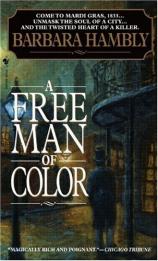A Free Man of Color
Review
A Free Man of Color
Barbara Hambly is an author well-known to readers of science
fiction, fantasy, and horror. She has written a number of
well-received Star Wars novels, including CHILDREN OF THE JEDI and
PLANET OF TWILIGHT. Her Star Trek novels, such as ISHMAEL, have
caused delight and controversy while playing with some of the
stereotypes which the characters in that legendary series are so
well known for. She has also created fantasy worlds of incredible
depth and imagination, as set forth in her classic DRAGONSBANE ,
the DARWAITH TRILOGY, and its successors. And her
unforgettable THOSE WHO HUNT THE NIGHT is required reading for
followers of vampire lore.
What is interesting, especially considering her varied
bibliography, is that Ms. Hambly's first love is history. Yet,
other than BRIDE OF THE RAT GOD, set in Hollywood in the 1920s, she
has rarely delved into matters historical. That, however, has
changed with A FREE MAN OF COLOR.
A FREE MAN OF COLOR is set in New Orleans in 1833. New Orleans,
then as now, was an extremely complex city, socially, politically
and economically, and, in matters of race. Incredible distinctions
were made with respect to those people of direct or mixed African
ancestry. People of direct African descent were black; people of
mixed white and black descent were referred to as being "of color,"
with further distinctions being made, by both white, and "colored,"
individuals on the basis of degree and extent of the individual's
heritage and skin shade.
Benjamin January is A FREE MAN OF COLOR, a musician educated in
classical music and a surgeon who has returned to New Orleans after
several years of schooling in Paris. January, seeking to ease the
pain and loss he experienced in Paris, experiences little succor in
New Orleans, where, even as a free man, he is still relegated to
second-class status. Unable to practice as a surgeon, he attempts
to eke out a living as a musician, playing at the balls and operas
which proliferated in New Orleans during this
time.
Among the many popular social events in New Orleans were the
quadroon balls. These were social events in which wealthy, white
Creole men would meet, and select, a quadroon (child of a mulatto
and full white) mistress. The man, or protector, would then support
his mistress, or placee, in high fashion, though he would do so
separate from his own household. Should he choose to terminate the
relationship, he would often provide a settlement to his placee
sufficient for her to continue to live in the fashion to which she
had become accustomed. And, all the while, the wife and/or family
of the protector would feign ignorance.
It is while playing at a quadroon ball that January is drawn into a
web of intrigue against his own desires. He encounters a masked
lady of his acquaintance, the recently widowed Mademoiselle
Madeleine, who is preparing to do what, for a white woman, is
simply unthinkable for that place and time: enter quadroon ball to
confront Angelique Crozat, her late husband's mistress. January
offers to function as an intermediary to arrange a meeting between
Madeleine and Angelique. His offer quickly goes awry however, when
Angelique is found brutally murdered at the ball.
The local authorities, given Angelique's place and station in
society, are initially reluctant to pursue the
matter. It accordingly is left to January to obtain what
justice he can for her by investigating the murder himself. As the
clues slowly point to the son of a wealthy, prominent, white New
Orleanian, however, January, to his horror, finds himself under a
cloud of suspicion which is growing ever larger and darker. The
investigation takes on a new urgency as he realizes that he must
find Angelique's murderer as much to obtain justice for her as to
save himself.
In A FREE MAN OF COLOR, Ms. Hambly has created a work which is part
historical novel, part history, and entirely fascinating, as she
draws the veil of time back through her flawless plotting, tireless
research and stunning characterization. Benjamin January is a
character who will endure in literature --- regardless of genre ---
as a good man, in a bad situation, trying to do what is right when
evil is all around him. Ms. Hambly's subsequent January novels ---
FEVER SEASON and GRAVEYARD DUST --- continue that tradition.
Hopefully, we will see much, much more of January from Ms.
Hambly.
Reviewed by Joe Hartlaub on January 22, 2011





